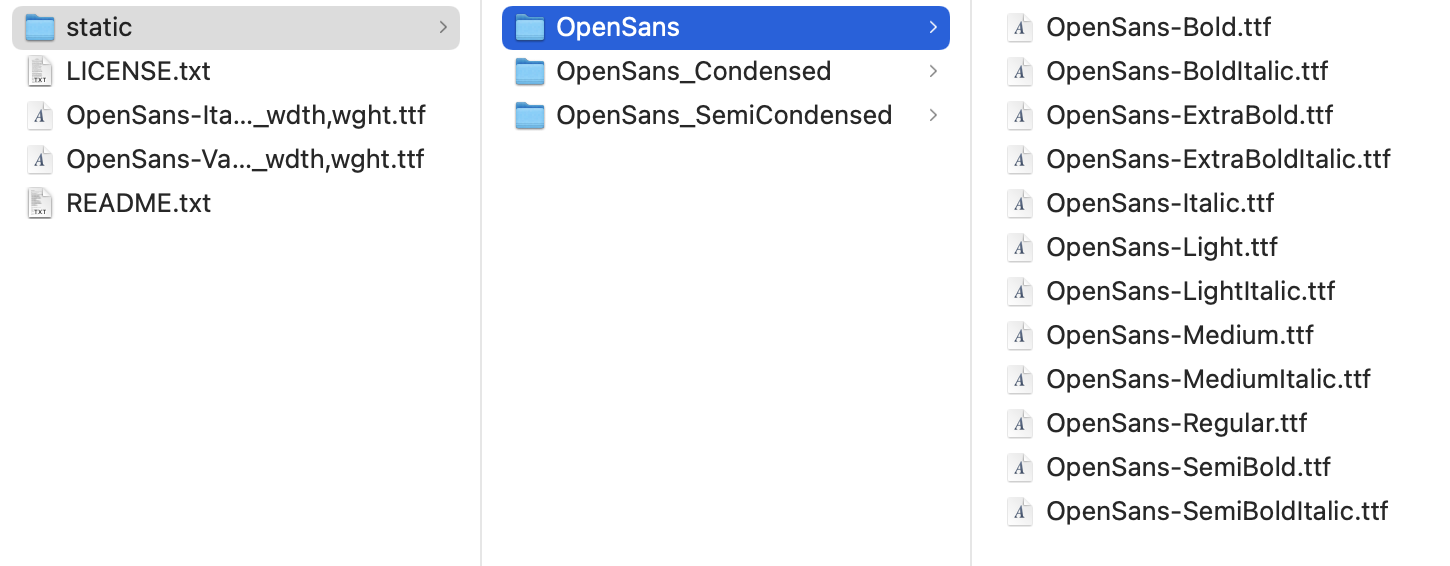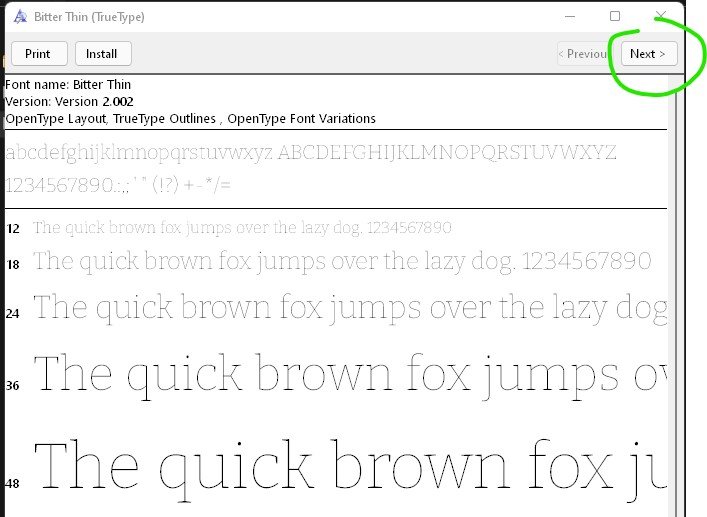Search the Community
Showing results for 'variable fonts'.
-

Affinity Publisher Using Tons of Memory & Slow
Old Bruce replied to amealz's topic in V1 Bugs found on macOS
Welcome to the forums @amealz, Off the top of my head I would check to see if the History is being saved with the document. File > Save History with Document should be unchecked. After that I would want to know if there are any fonts causing problems. How many fonts are on the MacBook and are any of them old school PostScript type 1 fonts. Are any of them Variable or Coloured Fonts? The Affinity suite does not work with them. -

Variable Weight Fonts from Google Not Parsed
matisso replied to JHutchinson's topic in V1 Bugs found on Windows
Switch to Figma, @JHutchinson. Just recently they implemented variable fonts support, among other useful updates. There is so many great things to be written about it, including the community they managed to build. regards, Matt -

Multiple same font only with Affinity
Komatös replied to alex83270's topic in V1 Bugs found on Windows
Hello @alex83270and welcome to the forums. Maybe you have the variable Font installed? This type of fonts are not supported from the Affinity programmes. -
@walt.farrell It turns out GF does have the current axis registry listed in a user friendly way. It is at the bottom of their variable fonts list - there is an Axis definitions tab. https://fonts.google.com/variablefonts#axis-definitions Those are just brief descriptions. The GF Knowledge info in-progress will expand on that with demo images, etc.
-

A font doesn't show all the styles
walt.farrell replied to nitro912gr's topic in V1 Bugs found on Windows
Welcome to the Serif Affinity forums. Probably, on the computer where it works you have the Static version of the font installed, and on the computer where it doesn't work you have the Variable version of the font. The Affinity applications do not support Variable fonts. The download file from Google Fonts should have a folder labeled Static containing the font files you need to use. -
Adobe published their Technical Note #5902 in September 2016. Title: Generating PostScript Names for Fonts Using OpenType Font Variations It is an update to the font naming conventions they wrote in previous PDF specs. Updated to include guidance on "best practices" when embedding variable fonts in PDFs. But what does Adobe know about PDFs? One of the things #5902 described was: Variations PostScript Name Prefix string (name ID 25) Which is an entry in the font name table to facilitate embedding variable fonts. Helvetica Now Variable includes a Variations PostScript Name Prefix string (name ID 25). It is almost like they expect users to embed the fonts. Avenir Next Variable ... same thing! The silly name ID 25 is also there too. Monotype, what do those fools know? Even worse, the idiots at Apple have name ID 25 in their variable interface font. Dummies! Don't even get me started on those Google Fonts bozos. They have 241 variable fonts available for download ... in a desktop file format. Where are the WOFF2 files for web use? Idiots! And Adobe PS, IL, and ID - all embedding variable fonts as text in PDFs ... wow. Simply unacceptable. Sketch on MacOS. Another app that has the audacity to embed variable fonts. Even Inkscape! As text! Blasphemy! None of the apps I have tested can cleanly round-trip variable fonts. But that is the same as static fonts. PDF is not designed as an editable document. Many users are using variable fonts in advanced apps creating PDFs which are then output. Today. The applications are lagging behind the variable font development. Affinity could be a leader here.
-
@walt.farrell Because nothing has happened regarding this in the "official" repo, Google Fonts established their own Axis Registry for their own use (and their web font API) and to provide some clarity to the entire variable font ecosystem. https://github.com/googlefonts/axisregistry It currently has 23 axes accepted into this registry. https://github.com/googlefonts/axisregistry/tree/main/Lib/axisregistry/data And there are many more axes proposed in the issues tracker: https://github.com/googlefonts/axisregistry/issues And there a few other proposals scattered around the GF repo. They do not treat this as "this is our way" but more of a place to get ideas, and feed back, and then to propose clear definitions of each axis to help everyone going forward. For example every one needs to be on the same page in defining the Italic axis vs. the Slant axis. So users will know what to expect when they encounter a font with these. There is also guidance on the "best" scale(s) to use the various axes, and why. I know this registry is not very helpful regarding clarity for the end user right now. But GF is currently working on an update to their GF Knowledge pages which will provide good descriptions of every axis - which will be very helpful for all end users. I see their updates and discussions almost every day as they work on this. You can see some examples of that here (they call it GFK): https://github.com/google/fonts/search?q=GFK&type=issues I am not sure of the timeline for publishing that, but they are diligently working on it. Since it is CC licensed we will be able to share it in different forms.
-

Variable Weight Fonts from Google Not Parsed
walt.farrell replied to JHutchinson's topic in V1 Bugs found on Windows
Variable fonts, from any source, are not supported in any Affinity application. You will need to install the standard fonts instead, rather than the variable fonts, or switch to a different application. -
Google Fonts does still provide static versions of their fonts along with the variable font files when downloaded. Look in the 'static' folder. Keep in mind if you add both the static and variable font files to many font managers you may end up with conflicts. Given that Affinity doesn't support variable fonts I currently only add the fonts in the static folder, and .zip up the static versions for later use. As for a solution to extract individual static weights of a variable font check out Slice. It's an app that not only generates static versions of a font from a variable font file, but also allows you to subset the fonts to reduce size and/or unnecessary glyphs.
-
I want to use fonts downloaded from google fonts, and they download as a variable font ttf. So, without this feature, I'm restricted in design options. They do correctly load in kind of, in so far as the list of weights is the same length as the weights in the family, but one weight takes place for every single one. I'd consider this a bug. I see the topic goes back two years. In absence of the feature, can anybody recommend solutions to extract the individual weights from the ttf as a workaround?
-
See top left, when installing a ttf file of variable weights from Google, they are not parsed correctly. Bitter-VariableFont_wght.ttf
-
How about SVG, which last time I checked was an output format that the Affinity apps supported? AFAIK (and from my limited experimentation) text elements in SVG documents can utilize variable fonts via CSS if the browser supports it. Lastly, having to constantly toggle variable/static fonts on and off when moving between applications that support variable fonts and those that do not gets old really quickly.
-
@walt.farrell don't forget that they are still very useful for folks exporting to bitmap and vector (via curve outlines) formats, providing them with additional flexibility to customize and tweak their text elements using the various axis provided. This is especially useful as doing significant vector manipulation of outlined fonts in Designer is not exactly a pleasant experience currently, and having to redo that work should the text change makes me weep. The importance of being able to retain those text elements as editable text shouldn't be overlooked just because the output is rendered static (without variable fonts).
-

Variable Fonts
walt.farrell replied to LLB's topic in Feedback for the Affinity V2 Suite of Products
My point in asking the question above was that the Affinity applications do not, today, support HTML or ebook (which is a form of HTML) output. And the uses you've mentioned (which I've highlighted above) seem to be in HTML/ebook contexts. Until that is supported by the Affinity applications, whenever that may be, the only use for variable fonts for Affinity users is in exporting to raster formats, or to vector formats (EPS, SVG, PDF) that also do not support variable fonts. And therefore even in the vector formats the user would have to choose to convert the fonts to curves (losing editable/translatable text) or the Affinity applications would need to turn into font generators and produce subsets of the variable fonts in a fixed-font format for embedding in the PDF files. That sounds very complex for an implementation, and I doubt it would happen. -
There is a discussion about variable font pricing on TypeDrawers (where major font developers hang out). And as you can imagine there are differing opinions and pricing strategies. Some just add-up the total of the static fonts replaced (which is dumb in my opinion). Others have priced the VF for less - acknowledging that most users do not buy all the statics now. But they too are trying to adjust to this new market. It is going to take awhile for it to reach a new level. Regarding web font pricing - I think it is insane (on some fonts). It amazes me that some people pay what look to me as ridiculous rates. Fun fact: Google Fonts (GF) changed the Open Sans web font to variable in August 2021 (most people did not notice anything as the replacement was seamless). A GF web fonts insider mentioned in a TypeDrawers discussion that in Oct. 2021 they were serving that font 40 billion times a week. With a B. In a week. For free.
-
While variable fonts do present significant hurdles for PDF export, the opportunities they bring to designers exporting to other formats are increasingly becoming well understood by many designers today. Being able to set font weights between the standard, static sizes (ie: 435 vs 400 or 500). The ability to mix different defined axis (slope, softness, serifs, wonkiness, etc.) exposed by the designers in order to fine tune the type to the context/design without having to convert the text to outlines is a big plus. The ability to tweak icon/emoji/illustrative fonts for the context is also really useful. And being able to define font-palettes to change the colours used in fonts supporting the COLRv0 (eventually v1) standard will enable designers to quickly change the color scheme of a font to match the overall composition. With more and more apps (Browsers, Embedded WebViews, Figma, Sketch, Illustrator, Cavalry, etc) supporting variable fonts it's only a matter of time before not providing support for them will become a liability for many. I'm not sure if the various eBook platforms are supporting them yet, but as they are all based off of existing web-standards it will likely only be a matter of time. As for exporting to PDF, variable fonts could be sliced/subsetted on export to static versions, or (not a great idea) convert them to curves on export. I know many folks are writing off variable fonts because of the not insignificant issues with PDF, but I fear in doing so we also limit ourselves from the potentials they already provide in other formats and contexts.
-
Depends on the application. The easiest thing to do just insert shapes. (wam bam "We Support Variable Fonts") InDesign inserts text which can be searched, screen readers work, edited, etc. There is an ongoing discussion in GitHub about how to best design a variable font interface. I hope Affinity asks for some early feedback when they decide to support variable fonts. Regarding how will variable fonts be used in Affinity apps ... Most users are going to easily understand the Weight and Width axes. But the Optical Size is going to be the most immediately useful to the most users. Adjustable Optical Size can have a noticeable effect on the quality. Google Fonts has been going thru all of their VF fonts and making the Optical Size (opsz) axis scales match up to the expected point size settings. This way in the interface you can link the opsz to the point size and always have the "optimal" optical size. This will help the beginner better results immediately, and help the "expert" hacks. Helvetica Now Variable has Weight, Width, and Optical Size axes. I am sure experts who design advertising for multiple media know how to use Optical Size properly. They can create ads for phone, tablet, desktop, TV, kiosk, light panels, billboards, etc. All properly optical size adjusted for display size and viewing distance. Experts will notice, and know how to use it well. Text book publishers can immediately use variable optical size. All static optical size fonts have a built-in design size which may not match the text. If a "caption" font design size is 6pt, when it is set at 9pt in the book it will look too dark. If a "text" font design size is 12pt, when it is set in the book at 10.5pt it is going to look too light. Same with the subhead, heading, and display static optical fonts. You would have to have hundreds of optical size static fonts to be optimal. Or one variable font which you can adjust exactly. Grade is the other axis which is immediately useful. Grade is like weight but there is no change in the character width. Some fonts have tabular figures which stay the same width over all weights, this is similar. Think of that for the entire font. Apple added Grade (GRAD) to their interface variable font in 2020. The upcoming Roboto Flex for Android will also add GRAD, and many other axes. Grade is very useful for interfaces, and for print forms where space is tight. Grade can also be an easy way to change the color of text without affecting the layout. Book text looks a bit light, tweak the grade to darken it a bit, and have no reflow (on 400 pages). There are other use cases, and advantages to advanced variable fonts. For example much higher level justification is possible (and has been demonstrated). The technology is rapidly changing. Early adopters and knowledgeable experts are using variable fonts now. The development of the variable fonts is happening very fast now. The applications are lagging behind.
-

Variable Fonts
walt.farrell replied to LLB's topic in Feedback for the Affinity V2 Suite of Products
Thanks, @LondonSquirrel. That's an interesting article that provides some insight into how applications like the Affinity suite could handle variable fonts. However, it also makes it clear to me that adding that support would be even more complex than I realized. -

Variable Fonts
michacassola replied to LLB's topic in Feedback for the Affinity V2 Suite of Products
@wonderings and @walt.farrell I think the need or want has been established by people requesting it here. The fax machine gets the letter across, why use email? (I am sure someone is going to make the argument for faxes after this ) If you research a bit you can find information to get to know this (new) technology and what it can be used for and is being used for (not just web by the way, otherwise no one would have requested it here 😉). https://fonts.google.com/knowledge/introducing_type/introducing_variable_fonts There have been other sources of information also posted before in this thread, that can be looked at, if the want to know why variable fonts are being used is real. For example this one: https://v-fonts.com mentioned by @fde101 Just go there please, play with some of the sliders in one of the examples and if that doesn't show you what variable fonts are about and why this kind of control might be good for design work of any kind online or offline... -

Variable Fonts
walt.farrell replied to LLB's topic in Feedback for the Affinity V2 Suite of Products
I have been wondering what people want to do with the Variable fonts. I guess they would work for creating raster artwork, or possibly for creating SVG files. They won't work in PDF files unless you convert them to curves during or before Export, as PDF doesn't support Variable fonts yet. Then you don't have editable text any more in the PDF file. -
I don't think I have been given a single file from any design house with variable fonts. Of course my experience is anecdotal but I am in no way panicked for variable fonts. I like the idea of them, but have never felt a need to really get beyond the standard font families that have thin, light, regular, medium, semi bold, bold, black. Even then most fonts do not have that entire set, they might be light, regular and bold. I wonder what the real difference is between want and need here.
-
Variable Fonts
Peter Martin replied to LLB's topic in Feedback for the Affinity V2 Suite of Products
+1 to add variable font support across the range of apps, starting with desktop. I'm having to seriously consider abandoning Affinity apps and returning to Adobe Creative Cloud apps. I love Affinity apps but variable fonts aren't just a novelty any more. -
Variable fonts
Redesignerer replied to DarkClown's topic in Feedback for Affinity Publisher V1 on Desktop
I'm trying to switch to Affinity in my work, at some of the big creative agencies, but no support for variable fonts is a deal-breaker. Also, no apparent desire to consider it means it is hard to persuade others to give Affinity a go. I'm using variable fonts more and more often, and I am now getting locked back in to Adobe as Affinity just pretend they don't exist. -
@LibreTraining, @walt.farrell Thanks for clarifying. I didn't know the GF fonts offered a choice between installing static and variable fonts. I don't recall being given a choice as to which to install, but I wasn't looking for one either. At any rate, I can reinstall the fonts as static and have them work in AD.






.thumb.png.b3d8c07e64c20eae79592dd0a9d79eff.png)
